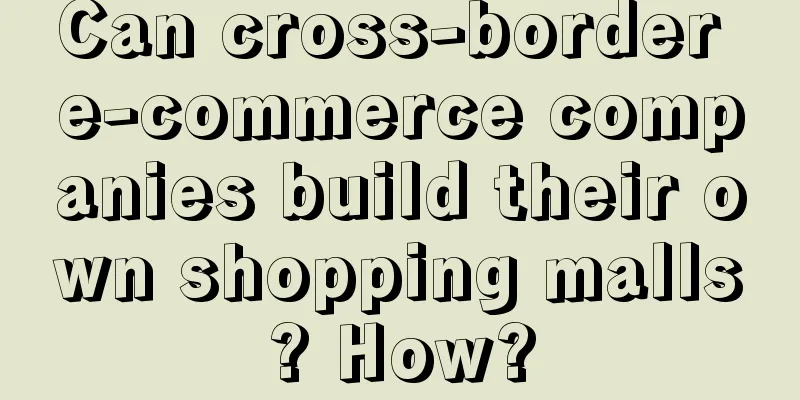Can cross-border e-commerce companies build their own shopping malls? How?

|
With the progress of global economic integration, cross-border e-commerce has become a huge business opportunity. However, it is not easy to carry out cross-border e-commerce operations in different countries and regions and achieve success. This article will explore how to carry out localized operations of cross-border e-commerce from multiple aspects. 1. Can cross-border e-commerce companies build their own shopping malls? When conducting cross-border e-commerce business, many people will face an important question: Can they build their own cross-border e-commerce mall? The answer is yes. Cross-border e-commerce can build and operate their own mall. With the development of technology and the popularity of e-commerce platforms, building a mall of your own has become relatively simple and easy. The advantage of building your own mall is that you can more flexibly control product types, prices, sales strategies, etc., while also being able to establish your own brand image. 2. How to do it? Determine the type of mall. First, if you want to run a cross-border e-commerce mall, you need to determine the type of mall. Common mall types on the market include B2C (business to consumer), C2C (consumer to consumer) and B2B (business to business). Choose a mall type that suits you based on your products and target customer groups. Register a company and obtain relevant licenses Before engaging in cross-border e-commerce operations, you need to register a company and obtain relevant licenses. These certificates may include business registration certificates, tax registration certificates, customs registration, etc. Depending on the regulatory requirements of different countries and regions, you may also need to go through some additional procedures and approvals. After determining the type of store and obtaining relevant licenses, the next step is to choose a suitable e-commerce platform to build your own store. There are many well-known e-commerce platforms to choose from in the market, such as Shopify, WooCommerce, Magento, etc. You can choose the most suitable platform according to your needs and budget. Once you have chosen the right e-commerce platform, the next step is to build your own shopping mall website and design an attractive user interface. This requires some technical and design knowledge. If you do not have this ability, you can consider hiring a professional web developer or designer to help you complete it. Finding suppliers and products A successful cross-border e-commerce mall is inseparable from high-quality suppliers and unique products. You can find suitable suppliers and products by participating in international trade fairs, establishing connections with overseas merchants, or using some B2B platforms. At the same time, you should also pay attention to ensure that the products you sell comply with the laws, regulations and quality standards of the target market. Establish a logistics and payment system. Cross-border e-commerce involves international transportation and payment, so you need to establish a reliable logistics and payment system. You can choose to cooperate with an international logistics company to ensure that the products can reach consumers safely and quickly. At the same time, you should also choose a safe and reliable payment method to smoothly collect payments from consumers. Finally, if you want your store to stand out in the fiercely competitive cross-border e-commerce market, you need to do a good job in marketing and brand building. This includes online advertising, participating in exhibitions, and cooperating with social media influencers. Through effective marketing and brand building, your store will be able to attract more target customers and increase sales. With the continuous advancement of technology and the opening of the global market, cross-border e-commerce can become a reality. By choosing the right type of mall, registering a company and obtaining relevant certificates, choosing a suitable e-commerce platform, building a website and designing a user interface, finding high-quality suppliers and products, establishing a reliable logistics and payment system, and doing a good job of marketing and brand building, you can successfully build a cross-border e-commerce mall yourself. Recommended reading: Which platform should I choose for my personal cross-border e-commerce business? What are the requirements for entry? How much does it cost for personal cross-border e-commerce? Do I need a deposit? Can cross-border e-commerce personal trademarks be registered? What are the regulations? |
>>: How much is the sales revenue of a cross-border e-commerce company? How to make good sales?
Recommend
What should I pay attention to when uploading toy products on Amazon? How to pass the toy category review?
There are different requirements for selling diffe...
Tourism changes: from outbound to county-level, no more high-end games
With the end of the 2024 May Day holiday, the tour...
What should I do if the shipment I send to Amazon is overweight? What are the requirements?
When shopping on Amazon or opening a store, you ne...
Do Shopee's newbie tasks count on Saturdays and Sundays? What tasks are there?
Many friends have to complete the novice tasks on ...
Is it necessary to pay the deposit of Shopee? What will happen if I don't pay it?
In fact, more and more people are now aware that c...
How many days does it take for Amazon to prepare goods? What are the advantages of self-delivery?
On the Amazon platform, Amazon merchants need to d...
What will happen to digital marketing in 2024?
Digital marketing has been developing in recent ye...
How long does it take for PayPal withdrawals to arrive? What are the rules?
Nowadays, when people use online shopping, each e-...
Product data analysis: optimize product strategy and improve sales conversion
The article discusses in depth how to optimize you...
Six ways to play with a food account, each one can earn money!
There are many food accounts on self-media platfor...
How can a novice seller on Amazon become a seller? How can a novice operate and make money?
As one of the world's largest e-commerce platf...
How much IQ tax has been harvested from us by the one-second head-changing technique?
With the rapid development of the Internet, e-comm...
Deconstruction before reconstruction
Through two vivid stories, this article explores h...
2023, not only private domain, but also growth!
Different user groups have different strategies fo...
Falling from the altar, what happened to Zhong Xuegao?
After the collective withdrawal of capital and the...









